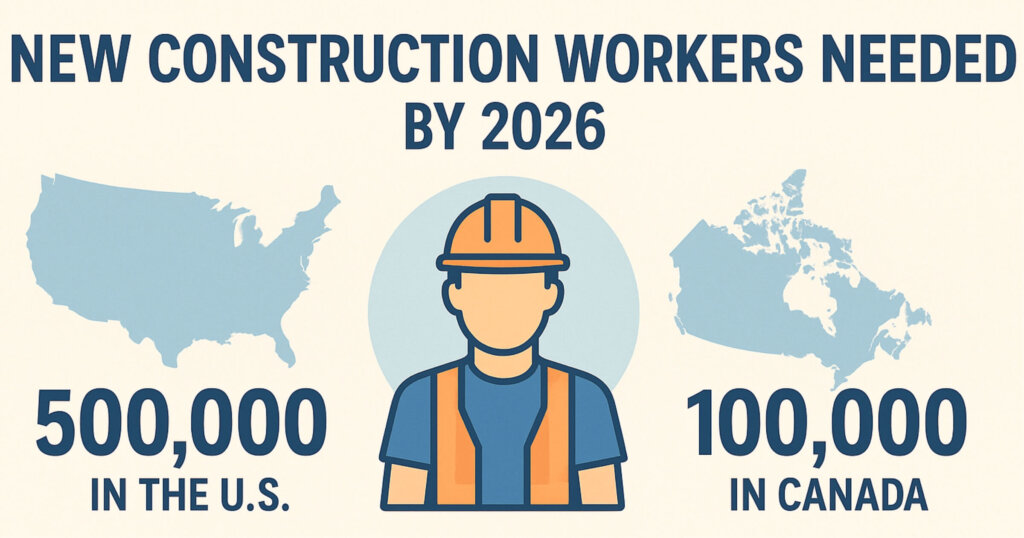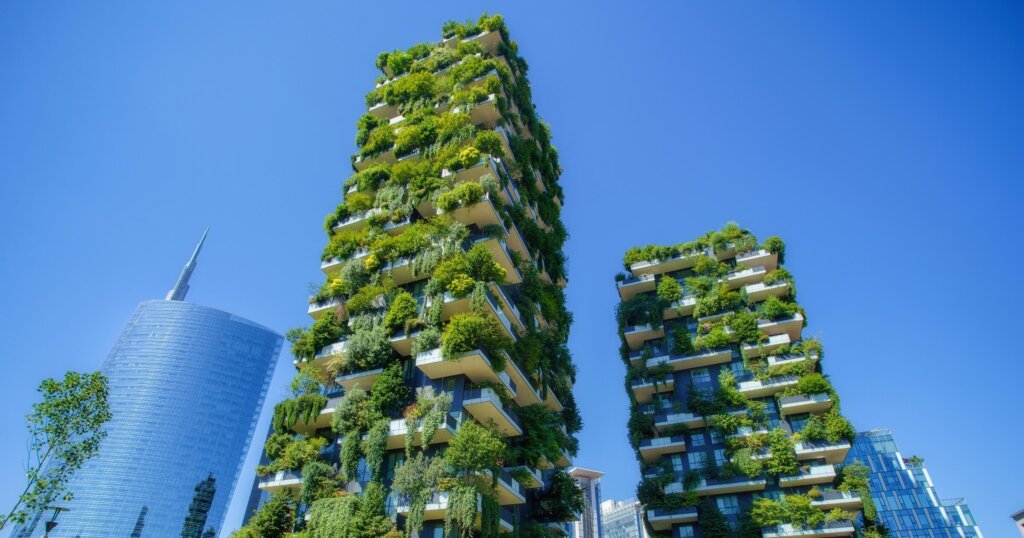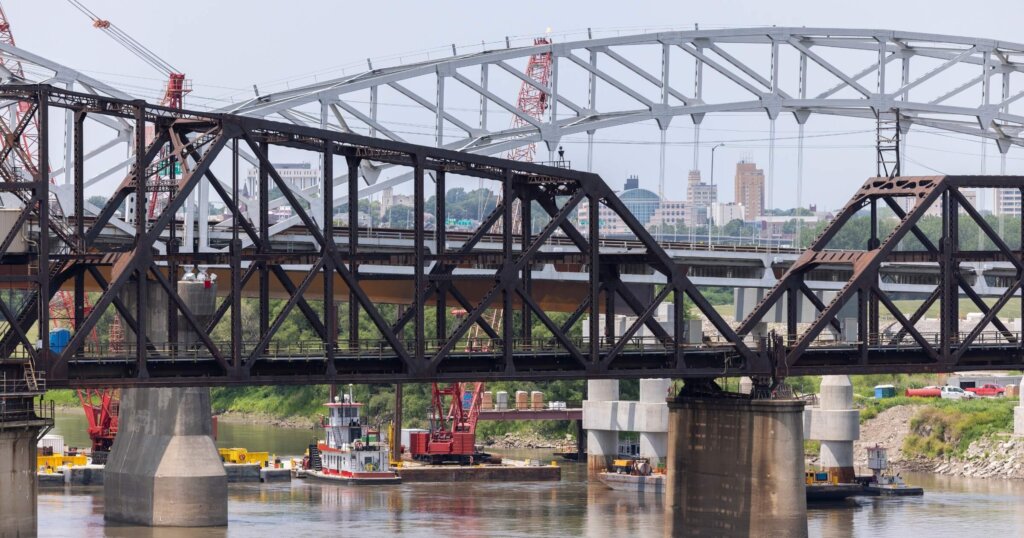Contractors are feeling the pressure in 2025 as the construction industry faces a growing list of challenges. From labor shortages and high material costs to AI disruption and new regulations, the way projects are planned and delivered is shifting fast. While innovation is helping to solve some of these problems, like agentic AI tools and panelized construction, many teams are still struggling to keep up. Below, we break down the biggest construction industry challenges builders are facing in 2025 and what’s being done to move things forward.
Challenge #1 – Skilled labor shortages
The lack of skilled workers remains one of the biggest construction industry challenges. With an aging workforce retiring faster than new talent is coming in, companies are scrambling to fill roles, from electricians and equipment operators to project managers and estimators.
With nearly 500,000 new construction workers needed by 2026 in the US and 100,000 in Canada, the industry is in dire need of workers at all levels. To make matters worse, recent data indicates that nearly 41% of the skilled labor force is expected to retire by 2031, and the industry isn’t on pace to replace them. The impact of skilled labor shortage has led to project delays, wage spikes, and an increasing reliance on short-term labor. This impact will only increase with time if this trend doesn’t change.

One of the main reasons behind the labor shortage is perception. Many young people still view construction as a fallback career rather than a forward-looking industry, despite growing demand and competitive pay.
Some firms are investing in new approaches to turn things around. Workforce development programs and trade school partnerships are gaining traction, while AI-powered training tools offer faster and more accessible upskilling.
Immigration reform has also been floated as a potential solution to fill immediate gaps in high-demand trades but this is still a temporary solution to a growing problem.
Challenge #2 – Supply chain instability
Even in 2025, supply chain unpredictability continues to disrupt construction schedules. Construction input costs rose in Canada by 0.8% in the first quarter of 2025, while in the US there was a total increase of 0.98%. This is in large part due to the supply chain volatility.
Global shipping bottlenecks, raw material shortages, and regional disruptions, ranging from extreme weather to geopolitical conflict, are making it harder for contractors to get the materials they need, when they need them. Lead times that once took weeks can now stretch into months, and backup plans have become standard operating procedure.
This kind of volatility drives up costs and increases risk across the board. Material prices fluctuate wildly, making accurate bidding a gamble. For smaller firms, even a single holdup can mean the difference between making a profit or taking a loss.
To stay competitive, many construction teams are re-evaluating their procurement management strategies. Some companies are shifting toward localized sourcing to reduce transit delays and carbon emissions.
Challenge #3 – Regulatory complexity and delays
Keeping up with regulations has become something of a full-time job for construction firms. In 2025, a wave of new energy codes, updated zoning laws, and increasingly complex permitting processes will slow down projects before they even break ground. While many of these changes are meant to improve building safety, energy efficiency, and community planning, they often add red tape and uncertainty to an already stretched industry.
Permits that used to take weeks can now take months, especially in large urban centers or regions adopting aggressive green building policies. These hold-ups increase pre-construction costs and make it harder to forecast revenue. According to a 2024 National Association of Home Builders report, permitting and regulatory delays have become a leading factor in rising housing costs, adding thousands of dollars to the average build.
Challenge #4 – Adapting to AI and automation

Image courtesy of Shutterstock
AI and automation are everywhere in 2025, and construction is no exception. From estimating software and scheduling assistants to full-blown digital twins that simulate builds before a shovel hits the ground, new tools are flooding the market. For an industry that’s constantly pushed to do more with less, the draw is obvious: better data, faster decisions, and fewer mistakes. But that doesn’t mean adoption has been easy.
As AI tools become more common, so do the growing pains. Some workers worry about being replaced, while others are struggling to keep up with the pace of change. There is also concern over how data is collected and used, especially on large projects where multiple contractors share platforms. And for small to mid-sized firms, figuring out which tools are useful and how to train people to use them is a challenge in itself.
Still, there’s a lot of promise. Agentic AI use cases are starting to show how intelligent systems can actively support—not replace—human decision-making on the job site.
Challenge #5 – Cybersecurity and data risk
As construction sites become more connected, the risk of cyberattacks is growing fast. With more teams using cloud-based software, remote access tools, drones, and smart sensors, there’s a lot more data flowing between the office and the field. As a result, there is a lot more opportunity for that data to be compromised.
While most people don’t think of this field when it comes to cybersecurity, the reality is that construction was the second most targeted industry for ransomware attacks last year, just behind manufacturing. Downtime from ransomware attacks or hacked systems can cost thousands per day, especially on large-scale commercial or infrastructure projects making this a major construction industry challenge to overcome.
To keep threats at bay, more firms are investing in secure, encrypted platforms designed specifically for construction workflows. These platforms limit access by role and offer backups to prevent data loss.
Challenge #6 – Climate adaptation and resilience

Image courtesy of Shutterstock
Extreme weather is a growing threat to construction projects across North America. Rising temperatures, floods, wildfires, and hurricanes are becoming more frequent and intense, forcing crews to pause work, re-evaluate building plans, and rethink long-term durability.
Meanwhile, the cost of insuring new builds is climbing fast in areas vulnerable to flooding or fire. In coastal and high-risk regions, builders are now factoring in climate resilience as a core part of project planning. Material failures caused by shifting temperatures or excessive moisture can mean costly rework, warranty claims, and lost client trust.
Builders are leaning into smarter solutions that focus on durability and long-term performance to adapt to the changing environment. Passive cooling strategies like reflective roofing, smart ventilation, and panelized construction, are helping keep buildings comfortable without cranking up the HVAC. In cities, green roofs are becoming more common thanks to their ability to soak up rainwater, reduce heat, and extend roof lifespan.
Challenge #7 – Integration of VR and AR
With growing pressure to reduce errors and improve safety, many companies are exploring VR and AR tools that offer better visualization, immersive training, and remote project walkthroughs. The tech promises a more interactive, mistake-proof workflow, but getting there takes time, money, and buy-in.
One of the biggest barriers to overcome this construction industry challenge is cost. Outfitting teams with tech devices requires a hefty up-front investment, which can be prohibitive for smaller firms. There’s also the learning curve to consider. The majority of construction workers are older and find the tech intimidating, while others question whether it’s worth the effort. Despite the excitement, many companies are still figuring out how to incorporate VR and AR into daily operations without slowing things down.
Challenge #8 – Mental health and worker well-being
Behind the hard hats and heavy equipment, many workers in construction are quietly struggling. Long hours, tight deadlines, isolation on remote job sites, and a culture that often discourages vulnerability have made mental health one of the industry’s most under-addressed challenges.
The impacts are hitting hard. Mental health struggles are directly linked to higher turnover, more frequent absenteeism, and even increased safety incidents on the job. Construction has one of the highest suicide rates of any industry in the U.S.; workers who feel unsupported are less likely to speak up or seek help, creating a cycle that can affect teams and their families.
To address this issue, companies are starting to provide access to on-site wellness resources, and peer-led support networks. While there’s still a long way to go, taking care of workers’ mental health is just as important as any PPE on site.
Challenge #9 – Urban density and vertical expansion

Image courtesy of Shutterstock
In growing cities across North America and beyond, space is running out, at least horizontally. With available land shrinking and property values climbing, developers are being pushed to build up, not out. But vertical expansion comes with its own set of challenges, including complex structural engineering to longer build times and higher construction risk.
High-rise projects demand more specialized labor, stricter safety protocols, and close coordination with local zoning and infrastructure. Add in tight timelines and congested urban environments, and the margin for error shrinks quickly.
Challenge #10 – ESG pressures and sustainability goals
With new government regulations, rising client expectations, and growing pressure from investors, construction firms are being held to higher environmental, social, and governance (ESG) standards. Whether bidding on public infrastructure or private developments, builders are now expected to prove how responsibly they’re doing it.
Firms must now track and report everything from carbon emissions and material sourcing to energy use and jobsite waste. That means increased administrative overhead, careful material vetting, and in many cases, prioritizing retrofits over new construction to meet climate targets. When 100 senior construction executives were surveyed about trends expected to accelerate due to the COVID-19 crisis, 53% cited sustainability as a main area of focus.
Challenge #11 – Aging infrastructure and deferred maintenance

Image courtesy of Shutterstock
Much of North America’s infrastructure is well past its prime. Roads, bridges, water systems, and public buildings are aging faster than they’re being repaired, mainly due to decades of underinvestment and the high costs associated with large-scale maintenance. In many cases, repairs have been deferred so long that replacement has become the only viable option, putting even more pressure on already stretched construction resources.
Crumbling infrastructure poses safety risks to the public, increases operational costs, and complicates urban development plans. The American Society of Civil Engineers continues to give U.S. infrastructure low marks, citing over $2.6 trillion in needed investment. As systems fail, demand for skilled labor and materials rises, pushing new projects further down the queue.
At the same time, new federal and regional infrastructure grants, like those introduced through the U.S. Infrastructure Investment and Jobs Act, are starting to flow into overdue repair projects, offering long-term funding for essential upgrades. The challenge now is maintaining momentum and transforming short-term fixes into lasting change.
Challenge #12 – Public perception of the construction industry
Even though construction is one of the backbone industries of the economy, it still can’t shake its image problem. Outdated stereotypes still shape how the public views the field. Construction rarely makes headlines, which means all the progress in tech, safety, and sustainability often flies under the radar.
This perception gap makes it harder to attract young talent, especially in a competitive labor market where tech and healthcare industries are seen as more forward-thinking. It also means that many of the industry’s most exciting innovations go unrecognized by policymakers and potential investors.
Want to learn more about the latest industry challenges and innovations? Subscribe to our newsletter for weekly updates and construction insights in architecture, engineering, and construction.


